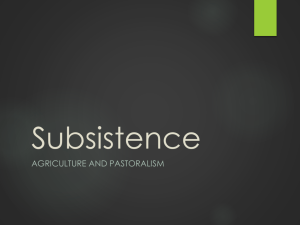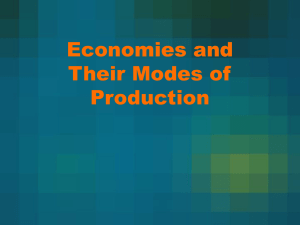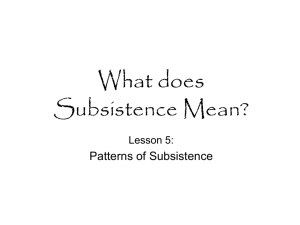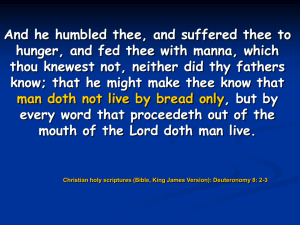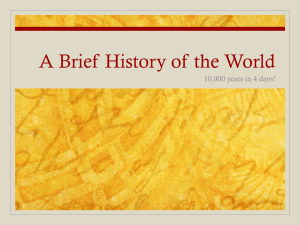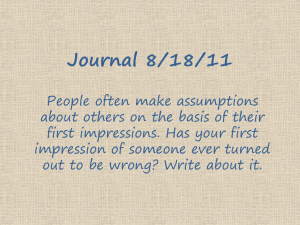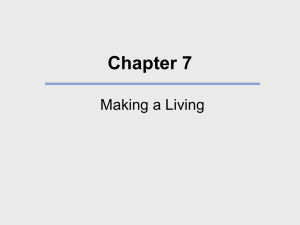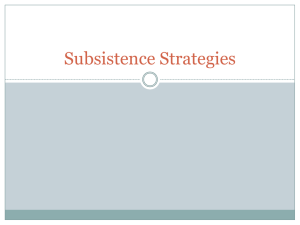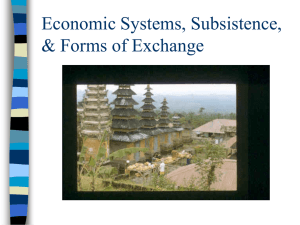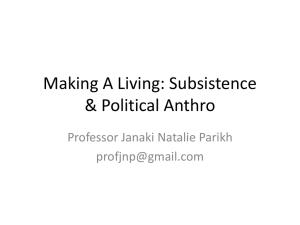Making a Living Subsistence Strategies
advertisement
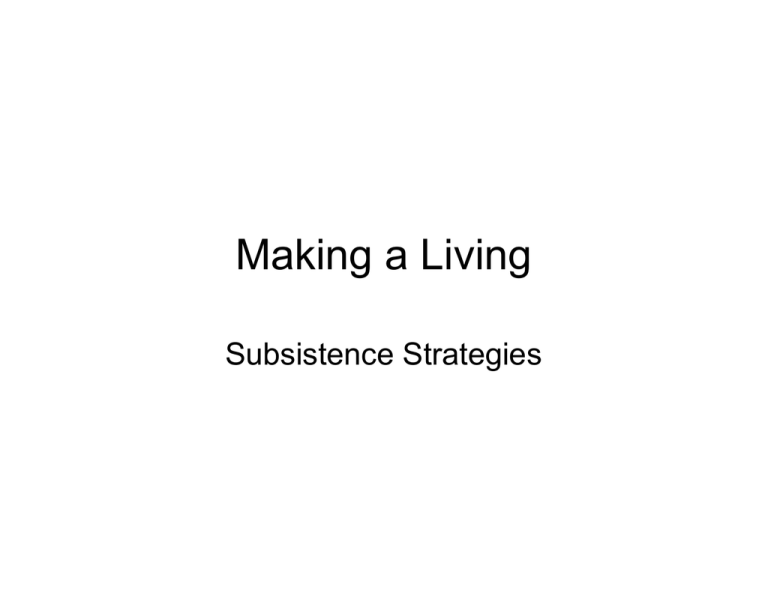
Making a Living Subsistence Strategies Ways of Making a Living • Determine all other aspects of culture • Hunting and Gathering to Industrialization=less leisured time • Hunter and Gathers not harsh existence • H&G work 2 to 3 days and rest 5 to 4 days • H&G Social Organization based on kinship • Flexibility in Camp Membership Subsistence Strategies • Ways in which societies transform the material resources of the environment into food clothing and shelter • Understand the effects of the physical environment on human activities and cultures • The effects of human cultures on the physical environment Strategies • • • • • • Hunting and Gatherers Pastoralism Horticulture Agriculture/Peasants Commercial Agriculture Industrial Development Foragers • Up to 10,000 years ago humans lived by foraging (hunting & gathering) • Follow the food • Territory • Foraging set limits on population growth and density and, consequently, on the complexity of social organization in their societies Hunter and Gatherers • Small population no more than 50 in a group • Egalitarian Society • Division of Labor based on Sex and Age • Women Gatherers contribute 85% of diet in fruits, berries, nuts and tubers • Men collaborate on hunting • Generosity key social value Foraging • Includes hunting of large and small game, fishing and the collecting of various plant foods • Strategy varies in productivity but in general support lower population densities • Rely mostly on vegetal collecting than hunting Exception • Inuit of Arctic Circle. No plant collecting • Culture adapted to availability of different animals in different seasons • Coastal Alaska Inuit depended on whaling and seal hunting • Animals provide not only food but also resources for material culture, such as layered clothing Inuit Women • No plant collection possible given Arctic environment. • Play less important role than women in most foraging societies • Do play vital role in distributing meat and processing meat for storage, making and repairing clothing, cooking and caring for children Aborigines Australian Desert • Wide range of vegetal food • Foraging not necessarily harsh existence even in desert environment • Less extreme environments, predictable plant foods can be supplemented by hunting • Aborigines select from available food items of high nutritional value Hunter & Gatherers • Original Affluent Society • Time spent gathering and hunting food is minimal • Generalized Reciprocity key to survival • Rich ritual and expressive culture • Gossip and ignoring are social sanctions • In extreme, force to leave camp H&G Social Group • Nuclear Family • Age respected for wisdom and knowledge of the environment • Arranged Marriages • Fathers help in Child raising • Bilinear Kinship Contemporary Hunters and Gathers • • • • • Botswana Environments marginal Do wage Labor Generalized Reciprocity breaking down Go on H&G trek 6 or 9 months and return to wage labor to have cash with which to buy consumer items Pastoralism • Food getting strategy that depends on the care of domesticated herds • Efficient way to exploit semi-arid natural grasslands that are otherwise unproductive • Does not compete directly with humans for the same resources Major Areas of Pastoralism • • • • • East Africa---Cattle North Africa—Camels Southwestern Asia---Sheep and goats Central Asia---Yak The Sub-Arctic---Caribou and Reindeer Key to Pastoralism • Herd Growth which depends on reproduction primarily on reproduction by herd animals • The number of animals needed to support a family is a constant source of pastoralism decision making • Herds constitute wealth Social Organization • Tend to be based in patrilineal kinship • Political organization is the Tribe • Among the Maasai, polygamous marriages • Women dependent on husband and son • Women given cattle to start herd for her sons Yarahmadzai of Iran • Varied seasons allow for varied diet, but milk is the stable food • Their flock are their capital: a renewable resource • Herding combined with other subsistence strategies • Camps migrate constantly between 5-25 miles each way to find grassland Contemporary Pastoralist • Depend less on consuming the direct products of their herd and more on the sale of their animal products for cash • Successful in adapting their products to local and global markets • Governments try to restrict pastoralist • Pastoralism cannot support an indefinitely increasing population Horticulture • • • • Tribal Society and Village Life Extended Families Do Some H&G Horticulture: production of plants using a simple non-mechanized technology • No plow, no chemical fertilizer • Cultivated fields not used permanently but remain fallow for some time after cultivation Horticulturalist • Plant and harvest with simple tools such as hoes or digging sticks and do not use draft animals • Fields have lower yield per acre than intensive agriculture; not much human labor • Grow enough for local group subsistence but not enough for local markets Local Groups • Amazon Basin in South America • Population densities are generally low, usually not exceeding 150 people per square mile • Villages may be quite large, ranging from 100 to 1,000 people • Horticulture is typically a tropical forest adaptation Swidden Cultivation • (Slash&Burn)—a form of cultivation in which a field is cleared by felling trees and burning the brush • Fields are used for a few years (one to five) and then allowed to lie fallow for a longer period (up to 20 years) so that forest cover to rebuild and fertility restored Social Organization • • • • • • Extended Family Patrilineal Descent Patrilocal Post-marital residence Population about 300 to 400 Amazonian Indians Males Dominant Division of Labor • • • • • • Men fell trees and burn forest Men clear the land Men dig holes and women plant crop Women weed and harvest crop Men and women fish Men hunt Crop Cultivation • Most cultivators plant several crops • Most horticulturalists shift their residences as they move their fields but some occupy villages permanently or at least on a long term basis • Land belongs to the tribe. No notion of private landownership

